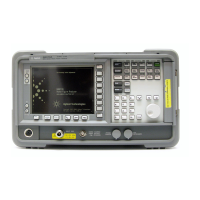Chapter 2 15
Test Descriptions
10 MHz Out Frequency Reference Accuracy
8. On Channel 1, press Trigger/Sensitivity until Auto Trig is displayed.
9. Use the arrow keys (
—>) to toggle to Off.
10.Press
Freq and Ratio.
Step 5. When the Universal Counter reading has stabilized, record the reading
in the Worksheet as Counter Reading 1 with 0.1 Hz resolution.
This reading is taken as the actual frequency reference of the NFA.
Ensure that the measured value is within the published specifications of
±5 Hz for the standard, or ±0.1 Hz for Option 1D5.
Step 6. Increase the NFA's fine DAC control by 1 step from its initial value.
Press the
System key, then the More, More and Service menu keys. Enter
the service password -2010, press
Enter, then press Service, Time Base,
and
Fine menu items. Press the Up Arrow key to increment the Fine
control menu item by 1. The value displayed in the
Fine menu item is
now 1 more than the initial value.
Step 7. When the frequency counter reading has stabilized, record reading in the
Worksheet as Counter Reading 2 with 0.1 Hz resolution.
Step 8. Decrease the NFA’s fine DAC control by 1 step to return to its initial
value detailed in step 6, then again decrease the NFA’s fine DAC control
by 1 step.
Step 9. When the frequency counter reading has stabilized, record the reading in
the Worksheet as Counter Reading 3 with 0.1 Hz resolution.
Step 10. Press
Preset on the NFA to return the DAC settings to their initial
values.
Step 11. Subtract Counter Reading 1 from Counter Reading 2 and record the
difference in the Worksheet as the Positive Frequency Change.
Positive Frequency Change = Counter Reading 2 - Counter Reading 1
Step 12. Subtract Counter Reading 1 from Counter Reading 3 and record the
difference in the Worksheet as the Negative Frequency Change.
Negative Frequency Change = Counter Reading 1 - Counter Reading 3

